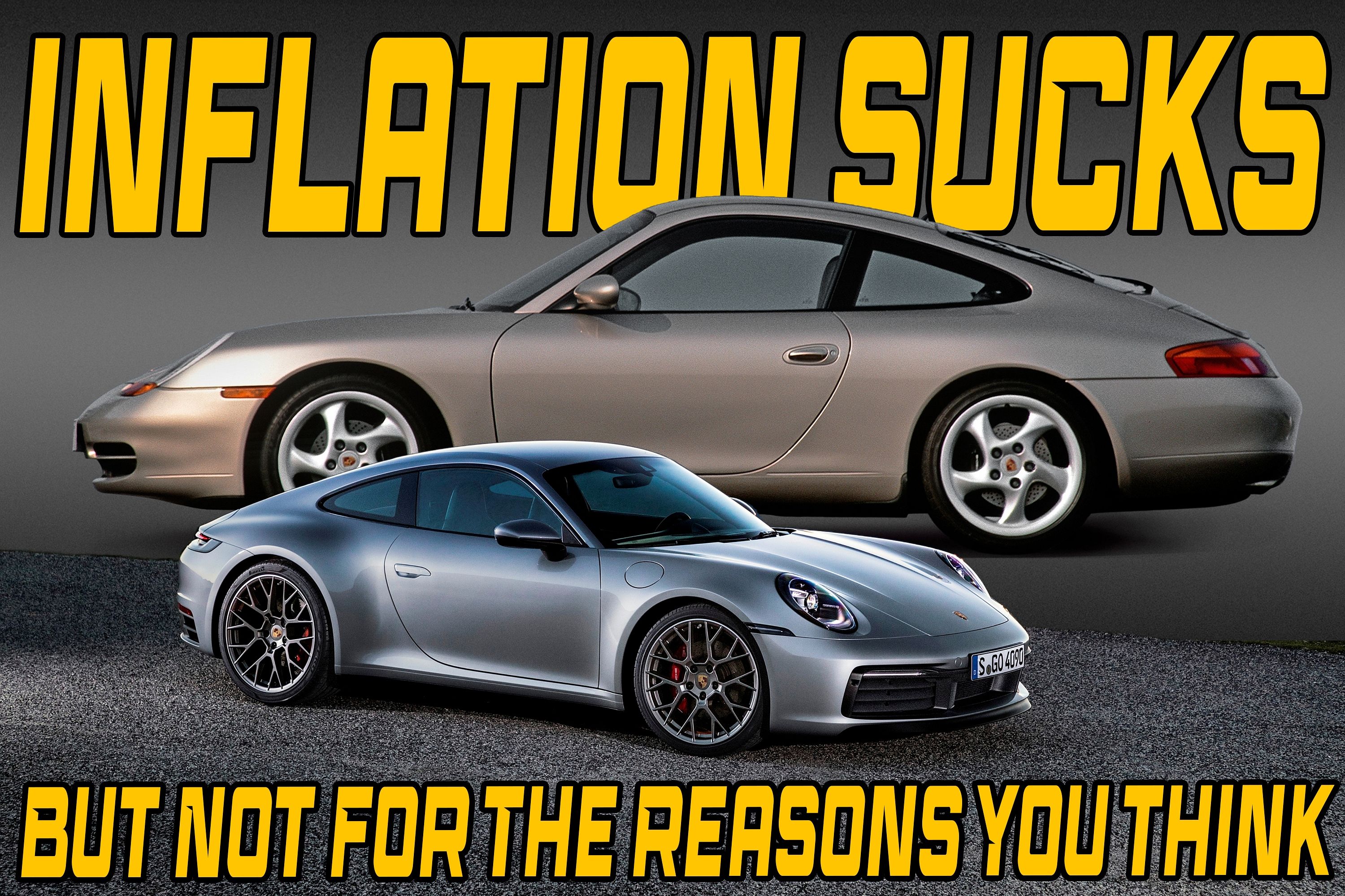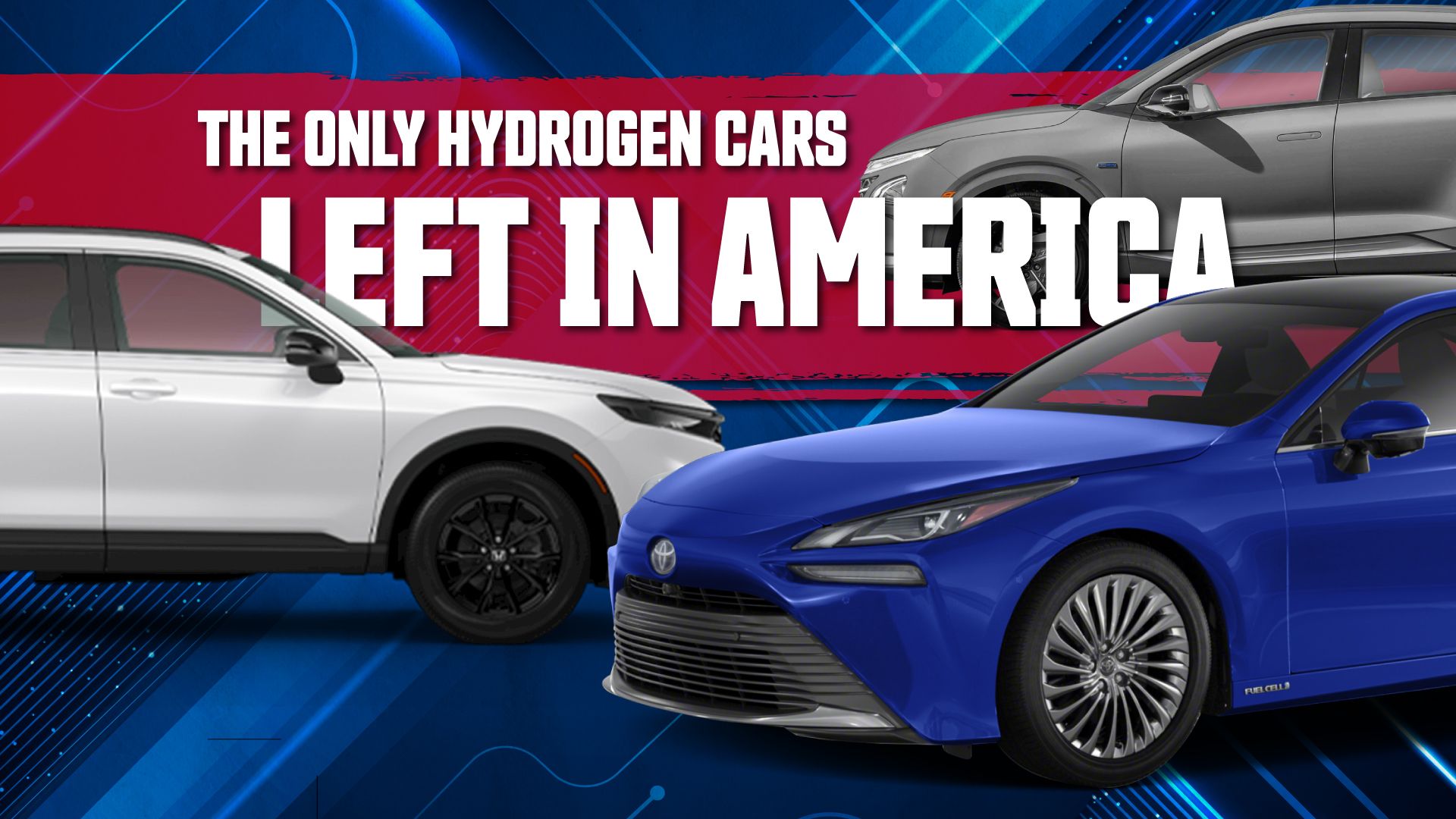“The future is electric,” you’ve been told by every automaker over the last five to eight years, each of them trying to push the next evolution of their product lineups with electric power. But despite pressure from global governments forcing automakers’ hands in this regard, manufacturers have felt the heat over the last year, with dwindling demand for battery electric vehicles (BEVs) forcing them to reevaluate their rapid transitions. Now, hybrids are all the rage, although many automakers still swear that the future is electric. But I’m here to tell you it’s not.
The future may have space for BEVs, but in the grand scheme of things, there will never be a one-size-fits-all solution. There never has been, and there never will be. Why? Because cars are more than just appliances. While sure, a lot of people view them as simple means of transport, they’re far more than that to auto enthusiasts. And even to the masses who aren’t enthusiasts, a car isn’t just a white good in the same way a fridge or a dryer is.
A car is an avatar of ourselves, something we expose to the world as an extension of who we are. Just like avatars in the online space, some are boring and generic – the Toyota Corollas and Subaru Imprezas of the world, inevitably painted some ambiguous shade of white or grey – while others are more striking. Some people customize their avatars with paint jobs, wheels, and modifications, while some just leave them as they were when they rolled off the showroom floor. Cars are more than just appliances – they’re akin to rolling wardrobes, visual representations of who we are to the outside world.
When viewed through that lens, it makes the concept of a one-size-fits-all EV-only solution even more absurd. Giving up on differentiating factors would be more than just sacrificing a means of transport; it would be giving up our sense of individuality.
So if the future isn’t purely electric, then what is it? Everyone has a different idea of what the future might hold, but what you’re about to read is how I envision the future of the automobile.
It’s Tech Week at CarBuzz, so we’re diving deep into the technologies that make the motoring industry tick, where they come from, where they’re heading, and what technology we can expect to see shaping the automotive industry in decades to come. Stay tuned for daily articles, interviews, and insights from the CarBuzz team on the technology shaping the future of the automotive world.
Electric Vehicles Will Still Exist, And Be The Volume Solution For Many
Wait, what? I just went on about how EVs aren’t the answer, and yet the very first piece of the puzzle to how I view the future is electric – that doesn’t make sense, does it? But hear me out. EVs still have a role to play. For some people, cars are just white goods, and for those people, they want the most efficient solution that effortlessly fits into their lives. BEVs do not fit in effortlessly into all lives, but for the average city-dwelling American, their daily commute means they can go a week or more without needing a significant recharge, and by plugging in overnight – something you may not even have to consciously consider once the likes of Hyundai’s charging robots become a reality – you’d not need to think about physically plugging in outside of a long distance road trip.
For these people, many of whom are environmentally conscious to some degree, reducing their emissions by driving an EV is a logical step. And yes, the research has been done, and automakers like Polestar are producing vehicles that are greener over their lifespan than their gasoline equivalents; at this stage, they only become greener when driven for more than 50,000 miles.
“BEVs aren’t the right answer for the whole world right now. They are for certain parts of the world but not everywhere.”
– Gill Pratt, CEO, Toyota Research Institute
Even if some commuters aren’t environmentally conscious, they’ll likely be financially savvy, and electricity is simply cheaper per mile than gas is. Why wouldn’t these buyers choose a vehicle that’s cheaper to run, especially when technology advances to the point of price parity between combustion cars and EVs?
DID YOU KNOW: According to the US Department of Energy, modern EVs are 2.6-4.8 times more efficient per mile than the equivalent gasoline-powered car.
Old Cars And Clunkers Will Remain On American Roads
A point that’s conveniently forgotten every time the EV-only future is brought up is that not everyone drives a new car. Heck, in 2024, the average age of cars on American roads reached an all-time high. According to S&P Global, cars in the US are now 12.6 years old, on average, meaning for every brand-new car on American roads, there’s effectively another 25-year-old car still trundling along. As vehicle prices increase and salaries fail to climb at the same rate, it’s becoming tougher for American buyers to afford new cars. Loan terms are getting longer, average new car prices are climbing, and with tariffs throwing a further spanner in the works, Americans are more likely to keep their existing cars than they are to buy new.

Related
New Cars Are NOT Too Expensive… You’re Just Not Being Paid Enough
Cars are cheaper today than they were 20 years ago.
I don’t see this changing 10 years from now, either, so while the new car market may see an influx of EVs, I think there will be an increasing market for older cars, too, driving support for maintenance parts and even fueling needs. Changing legislation might (try to) prevent buying a new combustion car, but it can’t eradicate the millions of combustion-powered cars already on the road. All the legislation talks about reducing tailpipe emissions to zero through new cars, but what about the millions of cars on the road now that will still be on the road a decade or two from now?
Synthetic Fuel Has To Play Its Part
I’m a huge advocate of synthetic fuel, largely because of the issue I brought up above. You can launch all the new EVs you want, but you’ll never get rid of the cars on the road currently, at least not in their entirety. Trucks will live on for decades, as will affordable commuters. And don’t even get me started on collectibles – not just the rare Bugattis of the world, but the Mazda MX-5 Miatas that have become appreciating assets. These will never die, so we’d best find a way to make them run cleanly.
I don’t believe in electromodding all of them; the concept of converting a combustion car to run on electricity only works when the engine you’re replacing wasn’t central to the driving experience. A classic Mini or DeLorean DMC 12 running on electrons is one thing, but a NA6 Miata, a Honda S2000, or a Mustang Shelby GT500 has no right to be powered by anything other than a combustion engine.
I’ve followed the synthetic fuel race closely, covering Porsche’s extensive developments of the stuff in partnership with HIF Global. I’ve sat opposite CEOs of Aston Martin and McLaren, had beers with the top dogs at Lotus and Bentley, and I’ve always picked their brains over synthetic fuel and its future in motoring. The significant majority of those influential people have advocated for it, and even when the automakers themselves have limited influence – like Lotus, which is struggling to stay afloat, let alone pioneer a new fuel source – they’re supporting those that do have influence. Aston Martin has partnerships with Aramco, for example, and through its Formula 1 involvement, the British brand is pioneering sustainable fuel.
I won’t go into the technical details here – there’s more on that coming later this Tech Week – but synthetic fuel is huge for the industry, utilizing only the carbon already present in the atmosphere to create hydrocarbons that fuel our vehicles in the same way as gasoline. It’s chemically identical to gasoline, but emits no more carbon than was already in the atmosphere to start. Sure, it doesn’t reduce the carbon out there, but by not adding to the problem, it’s creating a freedom for sectors that cannot reverse their carbon footprints entirely, like aviation, like shipping, like motorsport. And if car enthusiasts can benefit from this by keeping their sports cars running on combustion, then I support this fully.
“Up to a lifetime mileage of 160,000 kilometers, the total cost of ownership of a hybrid running on synthetic fuel could be less than that of a long-range electric car, depending on the type of renewable energy used.”
Hybrids Can Do The Heavy Lifting
I’ve spoken about EVs and sports cars above, about two ends of the spectrum in commuter appliances on the one hand and weekend toys on the other. But not every road user falls into one of those camps. Not every road user falls below the average American commute distance, which can easily be achieved on electricity alone. Some lines of work require covering vast distances, sometimes towing heavy trailers along the way. For some, there’s a mix of driving scenarios, or the necessity to operate in remote areas where an electricity supply isn’t a given. And that’s where hybrids come into play, alleviating the emissions burden through the efficiency of electricity but enabling the convenience of combustion and the ability to take extra fuel with you.
From trucks to family sedans, hybrids lessen the load on the system overall by providing flexibility, especially in the case of plug-in hybrids (PHEVs). In theory, a plug-in offers the best of both worlds, with less weight and greater range than a traditional EV, but with the ability to commute daily without consuming a drop of fuel – something that’s the case for the new Toyota RAV4 PHEV.
Hybrids will continue to exist, either as the primary vehicle for households who cannot adapt to a pure electric lifestyle or as a secondary vehicle for road trips and vacations. In day-to-day life, they can operate as EVs, but when covering vast distances, they can burn synthetic fuel for carbon-neutral motoring without the inconvenience of hour-long charging stops.
For trucks and delivery vans, hybrids play a role too, enabling heavier load-carrying and combining it with the ability to switch off the combustion engine when driving around town – the situation when emissions are at their greatest and fuel economy is at its worst.
Don’t Forget About Alternative Fuels Like Hydrogen
It would be very easy to say that hybrids and EVs have us covered when synthetic fuel is a reality, but I think pigeonholing the future of mobility into a black-white spectrum is short-sighted. I think it’s exactly that way of thinking that has landed us in the current predicament, where legislation forces EVs upon us when other alternatives exist.

Related
The Only Hydrogen Cars Left In America
Keen on buying a hydrogen-powered car? You have three models to choose from… at least for now.
Hydrogen may not be viable yet, but I don’t think we should discount it. BMW, Toyota, Hyundai, Honda, and several other automakers are investing heavily in its development for automotive use, despite the troubles facing it. Those troubles include finding a sustainable way to source ‘green hydrogen’ without creating more pollution, storing it in a way that doesn’t require huge amounts of space and see vast amounts lost through natural leakage, and making it affordable enough to become viable in mainstream vehicles.
Currently, hydrogen only has one use in the automotive scene – powering FCEVs, or fuel-cell electric vehicles. In this application, the hydrogen is fused with oxygen to create a release of energy and water. The energy released is harvested and powers electric motors. This means an FCEV doesn’t rely on a heavy battery, reducing its weight, and because hydrogen can be refueled quickly, it’s no more inconvenient than refilling a gas-powered car… aside from the fact that it’s nearly impossible to find hydrogen stations.
Hydrogen Combustion Is Another Angle To Pursue
But there’s another avenue for hydrogen: hydrogen combustion. Toyota is championing this, with several prototypes for road and racing, but it’s not alone. Mazda has been pioneering hydrogen combustion for decades, and even BMW gave it a go. Ford has patented hydrogen combustion V8s, and Yamaha launched a prototype V8 based on the Lexus IS 500’s motor that could run on hydrogen.
It faces several of the same issues FCEVs do, with the added hindrance of reduced power density for the amount of fuel you need to carry. But that doesn’t mean it should be written off. No technology reached maturity overnight, and there will still be advancements made here. Some markets may find it easier to run on hydrogen than others, and hydrogen, in either form, could become market-specific to suit the needs of the end user.
Public Transport Is A Huge Piece Of The Puzzle
This may be a contentious opinion, but I don’t believe everyone should be driving a car all the time. The world has driven us to believe that true freedom is owning a vehicle, that nothing says “I’ve made it” quite like driving around on your own terms. While I see that perspective (nothing gave me the feeling of freedom quite like the day I bought my first car), I also feel we need to be a little less selfish. As the population increases, we’re cramming more cars into the same space, and it’s not benefiting anyone. Cars are getting bigger, and I can’t for the life of me understand how it benefits anyone to have one person driving a massive SUV, taking up space on the road that could safely accommodate six people in the same vehicle.
Maybe it’s my small-car-loving mentality (I own two Mazda Miatas, so I love small cars), but it seems selfish, especially in cities. I’m not going to advocate for no one owning their own cars, but I don’t think we should be driving them as much as we do. I think society needs to establish better public transport in congested areas, enabling transport for the masses that is safe, efficient, and effective for commuters.
On the weekends, or outside of the dull commute, that’s when private mobility should be a thing. That’s when private cars should be used for convenience and fun. If a significant portion of the population views their vehicles as appliances, then they view them as a means to an end, and if we can make that means to an end more efficient, particularly spatially, we can reduce the load on the entire transport network.
There Is No Single Solution
More important than any single vision for the future I’ve outlined above is that none of these can exist in isolation. I don’t believe there is a single solution, and I think society needs to stop pushing for only one. Cars have never been a one-size-fits-all thing, so why are we trying to force them to be one now? Not everyone leads a lifestyle in which an EV makes sense. Not everyone wants the most efficient machine possible. Not everyone has access to hydrogen refueling or safe and reliable public transport. And that’s OK.
Just as we have an automotive society right now made up of V12 supercars and V8 muscle cars alongside three-cylinder eco-commuters, hybrid SUVs, and EVs, so too should the future of mobility be a melting pot of technologies and philosophies. If we can accommodate enthusiasts with synthetic fuel, then why shouldn’t we? It may not be undoing the damage combustion has already done to the environment, but if it’s no longer contributing to the damage, then I think that’s good enough. We need freedom to enjoy our hobbies and our passions, so long as they don’t hurt other people.
The important thing is that everyone requires a different mobility solution that fits their lifestyle and the technology and infrastructure available to them. If that’s another form of renewable fuel – like ethanol or seaweed-based biodiesel – then so be it. As Akio Toyoda succinctly put it, “Carbon is our enemy, not the internal combustion engine.”
I’ve spoken about this before, and I stand by what I wrote in 2022 when diving into synthetic fuels:
Since when did we settle for this idea that everyone needs to use the same technology? The old adage of variety is the spice of life rings true here, and bashing the personal choices of a group of individuals when it comes to what they drive is childish. We don’t mock someone for driving a convertible instead of a practical station wagon. We don’t all wear the same beige clothing because it’s cheaper to manufacture and less offensive on the eye. We don’t all eat the same food. So why should we begrudge someone for choosing an EV, or a hybrid, or a hydrogen vehicle that suits their lifestyle?
Synthetic fuels unlock yet another avenue, giving us choice. How would you like to be green? EV? Hydrogen fuel cell? Hydrogen combustion? Synthetic fuel? As long as no one is getting hurt and the environment isn’t being damaged, who cares which you choose? Choose the solution that best fits your needs, and let others do the same.
– Roger Biermann, CarBuzz Managing Editor








